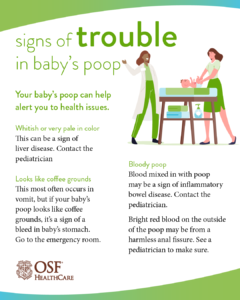
What to know about your baby’s poop
Babies poop.
It’s an unavoidable fact. But that poop is more than just a smelly nuisance. Baby poop can alert you if anything is going wrong inside your baby’s body.
“There’s no baby poop question I haven’t heard. ‘How often is healthy?’ ‘What should it look like?’ ‘What are worrying signs to look for?’” said Lynessa Alonso, DO, a pediatrician at OSF HealthCare.
She has some simple guidance.
The first few days
In the first 24 hours after birth, your baby’s body is clearing itself of the poop made while inside the womb. This poop is called meconium.
Meconium poop is usually thick, very dark green or black and tarry.
Sometimes, babies even have their first bowel movement during birth or delivery. Meconium may mix with amniotic fluid. This is not unusual and turns the amniotic fluid a shade of brown. Health care providers watch closely to make sure the baby isn’t showing any signs of distress or a problem with their heart rate if this happens.
“Newborns have meconium in their stool for the first three days, so you’ll see at least small amounts of dark black, greenish black sticky stuff in almost every diaper,” Dr. Alonso said. “And every time they eat, they usually poop.”
Healthy baby poop
As the meconium wears out, your newborn’s poop should turn brighter green, then greenish yellow before settling into a mustard yellow, grainy baby poop.
“It should look like it has little seedy things in it,” Dr. Alonso said.
Generally, babies on infant formula poop once or twice a day, and breastfed babies usually have a bowel movement every time they eat.
Children over 1 should poop once a day, and it should be soft. The frequency and consistency of their poop is usually reflective of their diet, though.
“If their diet is mostly fruits and veggies and water, they will poop more,” Dr. Alonso said. “If they have more carbs and dairy, they won’t poop as much.”
Baby poop colors
Dr. Alonso said most baby poop colors are pretty much OK. It’ll most likely be anywhere from green to yellow to brown, or a mix of all three.
Whitish or very pale poop can be a sign of liver disease. If your baby’s poop is white or pale, contact their pediatrician.
Some babies still have black stool after the first few days of meconium poop. This may be related to breastfeeding. If your nipples are cracked and bleeding, your baby may end up with a little bit of blood in their poop. Because it’s been digested, it comes out black. This is nothing to be concerned about.
You may also notice your baby’s poop color change if you switch to an iron supplemented baby formula. Iron supplemented formula tends to turn your baby’s poop dark green or black. Again, it’s nothing to be concerned about.
Once your baby is on solid food (at about six months old), their poop will change again. Their poop color will sometimes be the same as the food they ate.
Baby poop consistency
No two babies are alike, which means there’s a wide range of things considered normal.
“As long as the stool is soft and mushy, and your baby’s not uncomfortable, we say that’s OK,” Dr. Alonso said. “We usually don’t intervene unless your baby is pooping hard pellets.”
Breastfed baby poop is watery while formula-fed baby poop tends to be firmer, like the consistency of peanut butter.
Hard pellet-type poop is a sign your baby is constipated, which can make your baby very fussy and uncomfortable.
Having diarrhea – or a blow out – is not unusual for babies. Sometimes your baby’s tummy just seems to explode in their diaper. If your baby is having frequent diarrhea, talk to their pediatrician. It may be a sign of an allergy.
Your baby’s poop changes consistency when they start eating solid food. It tends to become more colorful, firmer and lumpy. You’ll probably see chunks of whatever your baby ate.
How to help your baby poop
If your baby’s having pain when they poop, or they need a little help getting it out, Dr. Alonso suggests you try giving your baby an ounce of prune juice. This is safe as long as you don’t give your baby more than an ounce or two of liquids a day (that aren’t formula or breast milk).
You can also try giving them a warm bath or getting your baby moving. Moving your baby’s legs like a bicycle can help.
If your baby is still constipated after two weeks, talk to your baby’s pediatrician.
Is my baby pooping blood?
Blood in the stool is not OK. If blood is mixed in with the stool, it may be a sign that your baby has inflammatory bowel disease. If you notice bloody baby stool, call your doctor immediately.
Baby poop troubles?
If there is bright red blood on the outside of the stool, it could just be from an anal fissure. This often happens after a bout of constipation and is not harmful. But you should get your baby checked out by the pediatrician just to make sure.
If your baby’s poop looks like coffee grounds, go to the emergency department. This is a sign of bleeding in your baby’s stomach. This sign of danger most often shows up in vomit, but it can show up in poop, too.
If it looks like your baby has blood in their wet diaper, it may not be blood at all. Sometimes babies have urate crystals in their diapers. It’s a completely harmless occurrence, but it can look concerning.
Urate crystals are a sign of your baby’s normal metabolism. It mostly occurs in the first few days, when their bodies are still flushing out the fluids from the womb.
Urate crystals look like a thin, chalky layer over the urine in your baby’s diaper. It is a reddish-brick dust consistency and color, which makes it look a little like blood. If what’s in your baby’s diaper doesn’t match the description of urate crystals, call the doctor.
